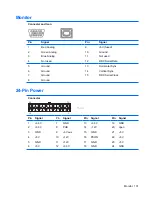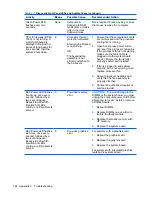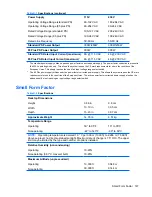
Poor performance is experienced.
Cause
Solution
Hard drive fragmented.
Defragment hard drive.
Program previously accessed did not release
reserved memory back to the system.
Restart the computer.
Virus resident on the hard drive.
Run virus protection program.
Too many applications running.
1.
Close unnecessary applications to free up
memory. Some applications run in the
background and can be closed by right-
clicking on their corresponding icons in the
task tray. To prevent these applications from
launching at startup, go to
Start
>
Run
(Microsoft Windows XP) or
Start
>
All
Programs
>
Accessories
>
Run
(Microsoft
Windows Vista) and type
msconfig
. On
the
Startup
tab of the System Configuration
Utility, uncheck applications that you do not
want to launch automatically.
CAUTION:
Do not prevent applications from
launching at startup that are required for
proper system operation.
2.
Add more memory.
Some software applications, especially games,
are stressful on the graphics subsystem
1.
Lower the display resolution for the current
application or consult the documentation that
came with the application for suggestions on
how to improve performance by adjusting
parameters in the application.
2.
Add more memory.
3.
Upgrade the graphics solution.
Cause unknown.
Restart the computer.
Blank screen (no video).
Cause
Solution
Monitor is not turned on and the monitor light is not
on.
Turn on the monitor and check that the monitor
light is on.
The cable connections are not correct.
Check the cable connection from the monitor to
the computer and to the electrical outlet.
You may have a screen blanking utility installed or
energy saver features are enabled.
Press any key or click the mouse button and, if set,
type your password.
Computer is in
standby
mode.
Press the power button to resume from
standby
mode.
CAUTION:
When attempting to resume from
standby
mode, do not hold down the power
button for more than four seconds. Otherwise, the
computer will shut down and you will lose any
unsaved data.
Solving General Problems 141


























